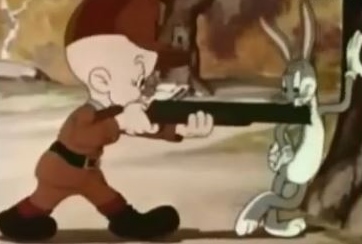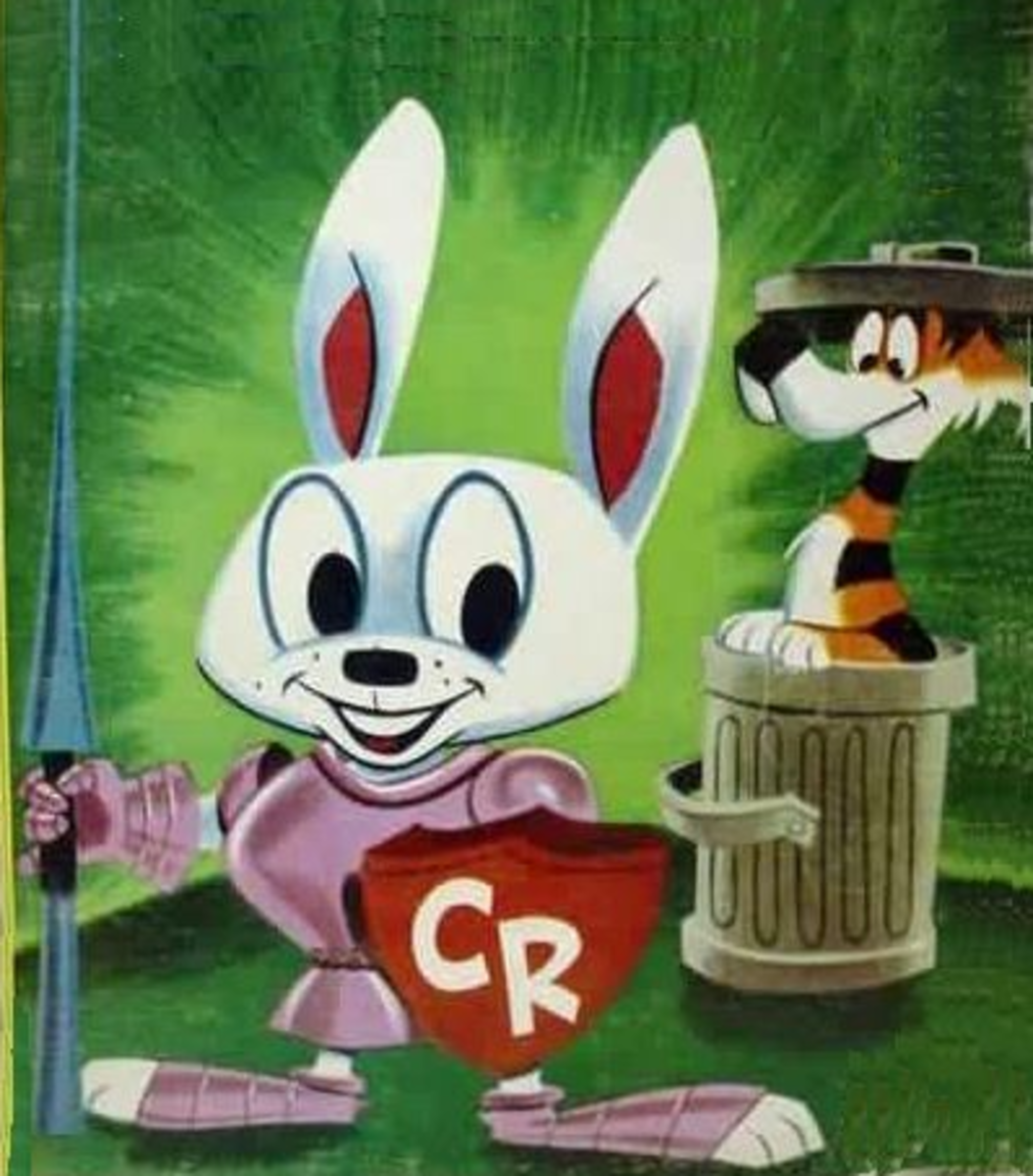Bugs Bunny

Bugs Bunny remains not only one of the greatest animated cartoon characters of all time, but also one of the all time great pop culture icons who continues to transcend generations -- given the fact that much has changed in almost the past century, including changing times and trends. And unlike other animated cartoon characters of their own eras who are hardly mentioned (or even remembered) today, Bugs' personality -- and soul -- has remained consistent, which remains a testament to his enduring popularity.
The early Warner Bros. animated cartoon characters created in the early-1930s, when the studio's animation department was first formed -- including Bosko, Foxy, and Buddy -- never became the breakout stars that Bugs and his many Looney Tunes and Merrie Melodies co-stars became later on, partially because the animated shorts of that period were pale imitations of those produced by Walt Disney (and not surprisingly, Rudolf Ising and Hugh Harman, who helped launch the Warners animation studio with producer Leon Schelsinger, worked for Disney during the 1920s).
In 1935, however, Friz Freleng's animated short I Haven't Got A Hat offered a glimpse of what would follow in the coming years, when it introduced Porky Pig, Warner Bros.' first cartoon superstar. Two years later, in 1937, Tex Avery introduced Daffy Duck to movie audiences in Porky's Duck Hunt -- further establishing the Warners' brand of animated cartoon humor that continues to influence not only animators, but also live action filmmakers.
It was Daffy's early personality as a crazy duck that would inspire Ben Hardaway's Porky's Hare Hunt (1938), in which Porky clashed with a rabbit who had more in common with Daffy than the Bugs Bunny that's well known today. (Hardaway's nickname "Bugs" would become the rascally rabbit's first name when his career took off two years later.) The early version of Bugs would appear in several more shorts in the next few years -- including Chuck Jones' Elmer's Candid Camera (1940), which is more remembered for the developing of Elmer Fudd, one of Bugs' chief comic foils in the decades to come (and who began his career as Egghead, another Tex Avery creation).
It was Tex Avery who helped develop and turn Bugs Bunny into the character that he became, starting with the 1940 Academy Award-nominated cartoon A Wild Hare, in which Elmer Fudd hunts Bugs (without any success). The cartoon's elements -- including Mel Blanc voicing Bugs with a combination Brooklyn-Bronx accent, and the character's famous catchphrase "Eh ... What's up, doc?", a prime example of the character's personality and reputation as a trickster -- would set the standard, and not only for Avery's fellow animation directors at Warner Bros., including Friz Freleng and Chuck Jones. It should be noted that Avery only directed three more Bugs Bunny cartoons before leaving Warners for MGM in 1941 -- including not only Tortoise Beats Hare (one of three spoofing Aesop's fable The Tortoise & The Hare), but also All This & Rabbit Stew, in which Bugs encounters a slow-witted African-American hunter (and which is now deemed racially offensive, like a significant number of Warners animated shorts that are hardly ever shown on TV these days, though they can be viewed on YouTube).
Bugs Bunny quickly became Warner Bros.' leading animated star during the 1940s, including the four years in which the United States was involved in World War II -- a great example of Bugs' popularity during the war years was Chuck Jones' Super-Rabbit (1943), a spoof of comic book icon Superman, which ends with Bugs dressed up in a U.S. Marines dress uniform and heading off to war (which led to the character joining the Marines for real). Bugs also made cameo appearances in several of the Private Snafu animated shorts that Warners produced exclusively for the U.S. Army.
Bugs was also instrumental in helping introduce other Warner Bros. cartoon characters who remain well-known today -- including Beaky Buzzard in Bob Clampett's Bugs Bunny Gets The Boid (1942); the Three Bears in Chuck Jones' Bugs Bunny & The Three Bears (1944); Yosemite Sam in Friz Freleng's Hare Trigger (1945); Marvin the Martian in Jones' Haredevil Hare (1948); Witch Hazel in Jones' Bewitched Bunny (1953); and the Tasmanian Devil in Robert McKimson's Devil May Hare (1953).
By the time World War II ended in 1945 (when Leon Schelsinger retired as Warner Bros.' animation producer, and was replaced by Edward Selzer), Bugs Bunny's popularity was still growing by leaps and bounds, thanks not only to appearing in animated shorts, but also guest appearances in the Warners movie musicals Two Guys From Texas (1948) and My Dream Is Yours (1949), with Friz Freleng directing the animation sequences for both (and the latter film featuring a cameo appearance by Tweety, another Warners cartoon superstar introduced during the war years). Bugs' popularity would also expand to not only various forms of merchandise featuring him and his cartoon cohorts, but also appearances in various comic books (including those currently published by DC Comics, which like Warner Bros., is owned by Time Warner), a long-running newspaper comic strip, and various audio albums (including those produced by Capitol, and later on, Rhino).
Some of the best Bugs Bunny animated cartoons from the post-World War II era came courtesy of director Chuck Jones and writer Michael Maltese -- including not only a trio of shorts in which Daffy Duck attempts (and fails) to trick Elmer Fudd into hunting Bugs (Rabbit Fire [1950], Rabbit Seasoning [1952], and Duck! Rabbit! Duck! [1953]) -- but also such classics as Long-Haired Hare (1949) and Bully For Bugs (1953), in which the rascally rabbit encountered (and eventually defeated) a supposedly superior adversary. Jones also directed two significant Bugs Bunny cartoons that were released during the 1950s: Lumber Jack-Rabbit (1954), the only Warner Bros. animated short released in 3-D. which shut down the animation studio (if only temporarily) -- and What's Opera, Doc? (1957), which combined the familiar Bugs and Elmer Fudd conflict with the operas of German composer Richard Wagner.
But it was Friz Freleng who would direct Knighty-Knight Bugs (1958), the only Bugs Bunny short to win an Academy Award -- and the last Warner Bros. animated short to date to be so honored (Warners had previously won five Oscars for its animated shorts that were released between 1947-57); the cartoon's plot placed Bugs in the time of Britain's King Arthur, as he clashed with Yosemite Sam (as the Black Knight).
By the late-1950s, the classic Warner Bros. animated shorts from the 1930s and 1940s started to be shown on TV, including those starring Bugs Bunny. In the fall of 1960, The Bugs Bunny Show debuted on ABC, which combined theatrical shorts with new framing sequences directed by Chuck Jones, Friz Freleng, and Robert McKimson. After two seasons' worth of first-run episodes, The Bugs Bunny Show would live on in Saturday morning reruns for the next thirty-eight years on both CBS and ABC, with the Road Runner (and later, Tweety) sharing top billing with him; in 2000, Bugs and his cartoon cohorts left network TV for good when Cartoon Network gained the exclusive cable TV rights to the classic Warners animated shorts.
In retrospect, while television helped to further cement Bugs Bunny and his fellow Looney Tunes characters' popularity, it also helped to end animation's Golden Age in the late-1950s and early-1960s, with rising costs and declining interest in motion picture short subjects also contributing to its demise -- and not even the Warner Bros. animation studio was immune to such changes. The final Bugs Bunny animated short released during the 1960's -- False Hare -- was also one of the last released by Warner Bros. in 1964, roughly a year after its animation studio shut down. Warners would resume releasing animated shorts only a few months after the release of False Hare and would continue to do so until 1969 -- but Bugs Bunny wasn't featured in any of the animated shorts released between late-1964 and 1969. The character's only on-screen appearances during the mid-to-late-1960's and early-to-mid-1970s would be on TV, mainly in TV commercials (including those for Kool-Aid, which were directed by Tex Avery).
By the 1970s, there was renewed interest in the classic Warner Bros. animated shorts, including those starring Bugs Bunny. Between 1975-89, six feature films featuring both classic Warners cartoon shorts and all-new footage -- including Bugs Bunny Superstar (1975) and Chuck Jones' The Bugs Bunny-Road Runner Movie (1979) -- were shown in movie theaters, while nineteen TV specials headlined by Bugs aired between 1976-92, including four that consisted entirely of all-new animation, courtesy of directors Chuck Jones and Friz Freleng (including Jones' superb A Connecticut Rabbit In King Arthur's Court [1976]). In 1988, Bugs and his some of his Warners cartoon cohorts made cameo appearances in Who Framed Roger Rabbit? (Touchstone, 1988), which marked one of the last times that Mel Blanc would voice those iconic characters before his death in 1989. (Since Blanc's death, voice actors like Jeff Bergman and Billy West have voiced Bugs.)
During the early-1990s, Bugs Bunny and the classic Warner Bros. cartoon characters made frequent appearances on the animated TV series Tiny Toon Adventures -- as well as cameo appearances in later Warners animated TV shows like Animaniacs. From 2002-06, infant versions of Bugs and the other Looney Tunes characters appeared on Baby Looney Tunes, which aired on both the now-defunct WB TV network and Cartoon Network.
In the past few decades, Bugs Bunny returned to motion picture screens in not only several animated shorts, but also the feature films Space Jam (1996) and Looney Tunes: Back In Action (2003), which combined animation and live-action. Bugs Bunny's most recent on-screen appearances in the past few years have been on The Looney Tunes Show, which aired on Cartoon Network in 2011-14 -- the series updated Bugs and company for the 21st Century, while giving it more of the flavor of a TV situation comedy (including Bugs and Daffy Duck sharing a house in the suburbs).
The next Warner Bros. animated TV series to spotlight Bugs Bunny -- Wabbit -- a return to the slapstick humor that was a hallmark of the classic Warners cartoon shorts will debut on cable TV's Boomerang (another Time Warner company) in the fall of 2015, in conjunction with the character's 75th anniversary. How it'll fare remains to be seen -- but there's no doubt that Bugs Bunny's popularity and place in show business history remains intact. And to paraphrase Bugs' fellow cartoon co-star Porky Pig -- that's definitely not all, folks.






